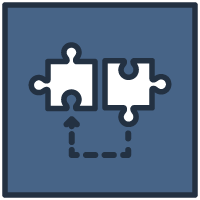Lesson 7: Family-Professional Partnerships
A key part of what family engagement coordinators (FECs) do is help families improve their ability to effectively communicate and engage with educators and other service providers to obtain appropriate services for their children. This lesson covers communication strategies for working together and preventing and managing conflict.
Resources in this lesson were developed by the Center for Appropriate Dispute Resolution in Special Education (CADRE), which is funded by the U.S. Department of Education’s Office of Special Education Programs.

Knowledge and Skills Addressed
- Processes and resources that families can use to prevent and address conflict in early intervention and educational settings
- Model and teach teaming and communication strategies that enhance family-professional partnerships
Learning Activities
Effective Communication
Effective communication strategies help families develop and maintain strong partnerships with schools and early intervention providers. Steps to Success: Communicating with Your Child’s School provides an overview of strategies families can use to work effectively with schools and educators.
CADRE also has five self-directed courses for families called the Working Together Series, which you may want to recommend to families:
- Course 1: Introduction to the Working Together Series (30 minutes)
- Course 2: IEP Meetings and Beyond (1 hour 40 minutes)
- Course 3: Listening and Responding (33 minutes)
- Course 4: Managing and Responding to Emotions (38 minutes)
- Course 5: Focusing on Interests to Reach Agreement (55 minutes)
To familiarize yourself with the format and nature of these courses, we recommend completing Course 3 on listening and responding.
Dispute Resolution
When disagreements develop, families and schools often need additional support to resolve conflicts. Although FECs should not get involved in conflicts, they can let families know where to find reliable resources on conflict and dispute resolution. To familiarize yourself with dispute resolution processes for families of early intervention and school-age children, read the top two rows of the following documents:
- Early Intervention Dispute Resolution Process Comparison Chart (Quick Guide)
- Quick Guide to Special Education Dispute Resolution Processes for Parents of Children & Youth (Ages 3-21)
Assignment
Think of a family of a child who is deafblind that you are currently working with or have worked with that needs to increase their knowledge and skills related to partnering with professionals. Answer the following questions:
- What is their current level of knowledge and skill?
- What difficulties have they encountered?
- What resources on this topic do they already have?
Go to CADRE’s Resources for Families. Browse through the "Learn More" options, and find two resources you would recommend to the family.
If you don't have an example family in mind, use this scenario:
A family just moved to a small rural school district in Iowa that has never served a child who is deafblind. It is apparent that the administrators and educational team need to learn more about the impact of combined vision and hearing loss on learning and the unique needs of the family’s son, a 5th-grader who has CHARGE syndrome.
Additional Resources
To learn more about effective communication, take other courses in the Working Together Series.
For more information about dispute resolution processes, see
